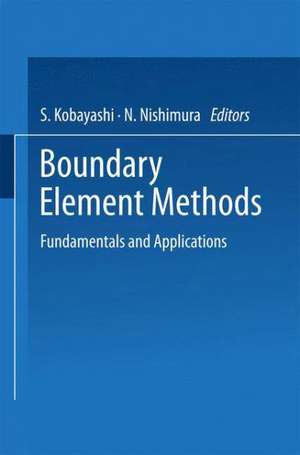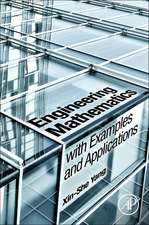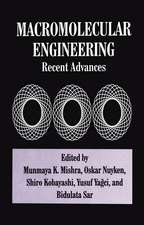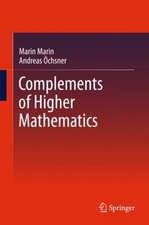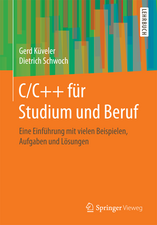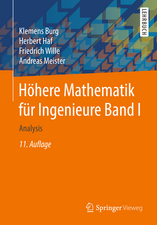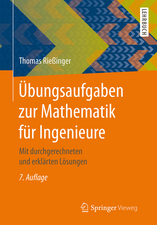Boundary Element Methods: Fundamentals and Applications
Editat de S. Kobayashi, N. Nishimuraen Limba Engleză Paperback – 15 apr 2014
Preț: 646.62 lei
Preț vechi: 760.73 lei
-15% Nou
Puncte Express: 970
Preț estimativ în valută:
123.73€ • 129.53$ • 102.38£
123.73€ • 129.53$ • 102.38£
Carte tipărită la comandă
Livrare economică 05-19 aprilie
Preluare comenzi: 021 569.72.76
Specificații
ISBN-13: 9783662061558
ISBN-10: 3662061554
Pagini: 424
Ilustrații: X, 412 p. 271 illus.
Dimensiuni: 155 x 235 x 30 mm
Greutate: 0.59 kg
Ediția:1992
Editura: Springer Berlin, Heidelberg
Colecția Springer
Locul publicării:Berlin, Heidelberg, Germany
ISBN-10: 3662061554
Pagini: 424
Ilustrații: X, 412 p. 271 illus.
Dimensiuni: 155 x 235 x 30 mm
Greutate: 0.59 kg
Ediția:1992
Editura: Springer Berlin, Heidelberg
Colecția Springer
Locul publicării:Berlin, Heidelberg, Germany
Public țintă
ResearchDescriere
The Boundary Element Methods (BEM) has become one of the most efficient tools for solving various kinds of problems in engineering science. The International Association for Boundary Element Methods (IABEM) was established in order to promote and facilitate the exchange of scientific ideas related to the theory and applications of boundary element methods. The aim of this symposium is to provide a forum for researchers in boundary element methods and boundary-integral formulations in general to present contemporary concepts and techniques leading to the advancement of capabilities and understanding of this com putational methodology. The topics covered in this symposium include mathematical and computational aspects, applications to solid mechanics, fluid mechanics, acoustics, electromagnetics, heat transfer, optimization, control, inverse problems and other interdisciplinary problems. Papers deal ing with the coupling of the boundary element method with other computational methods are also included. The editors hope that this volume presents some innovative techniques and useful knowl edge for the development of the boundary element methods. February, 1992 S. Kobayashi N. Nishimura Contents Abe, K.
Cuprins
An h-Adaptive Boundary Element Method and Evaluation of Error.- Implementation of FE-BE Hybrid Techniques into Finite Element Programs.- Optimum Location of Electrode in Cathodic Protection System.- Vibrations of Reissner Plates by BEM and D/BEM: A Comparison.- Numerical Approximation of Boundary Integral Equations in Three Dimensional Aerodynamics.- Shape Sensitivity Analysis of Uncertain Static and Vibrating Systems Using Stochastic Boundary Elements.- BEM Analysis of Crack Propagation in Concrete Based on Fracture Mechanics.- On Free Space Green’s Function for High Order Helmholtz Equations.- Boundary Element Model for the Seismic Analysis of Arch Dams.- Stability of Time Domain Boundary Element Method in Wave Propagation Problems.- Computational Aspect of Ground-Water Management.- Dynamic Crack Contact Analysis by Boundary Integral Equation Method.- Current Status of the GENESIS Methodology for Knowledge-Based Treatment of Transonic Flows, with Emphasis on Shock Fitting and Non-Dissipative Supression of Expansion Shocks.- A Boundary Element Analysis of Space Charge Fields.- A Time-Stepping Boundary Element Method Applied to Transient Thermoelasticity.- Calculation of Aerodynamic Characteristics of a Heaving and Pitching Airfoil by a Panel-Vortex Method.- BEM-WFDM Coupled Analysis for Groundwater Resources.- Approximation Analysis on 3-Dimensional Coupled Electric Potential and Hole or Electron by Boundary Element Method.- The Completed Double Layer BIEM: A Boundary Integral Method for Complex Microstructures in a Viscous Fluid.- Boundary Element Methods for Crack Problems.- An Easy Adaptive Boundary Mesh for 2D Elastic Problem.- Boundary Element-Node Condensed Finite Element Method for Three Dimensional Elastic Wave Propagation Problems.- The Analytical Integration of Boundary Integrals for Plate Bending.- Identification of Corrosion Profiles in Computed Thermal Tomography by a Volterra Integral Equation of the Second Kind.- A Mixed-Hybrid Variational Formulation for Coupling BEM and FEM in Elastostatics.- Sensitivity Analysis of Steady-State Heat Conduction Problems Using Boundary Element Method.- A General Theory of Potential Aerodynamics with Applications to Helicopter Rotor-Fuselage Interaction.- Regularised Boundary Integral Equations for an Inverse Problem of Crack Determination in Time Domain.- Boundary Integral Equation Defined on a Crack Approximated with Voids.- Boundary Element Analysis of Frictional Slip Behaviour in Contact Problems.- Three-Dimensional Long Time Prediction of Nuclides Migration by Boundary Element Method.- Trefftz-Type Boundary Elements for Plate Problems.- Brittle Fracture Materials by BEM and R-Functions.- The Sweeping Primitive used for 3D Automatic Boundary Element Mesh Generation.- Direct Differentation Approach to Boundary Element Method for Nonlinear Water Wave Problems.- A Formula for the Boundary Integral in the Potential Problem of Two-Dimensional Anisotropic Materials and its Evaluation.- BEM Analysis Applied to the Electric Field near the Edge of Compound Dielectric Materials.- Analysis of Certain Inverse Problems in Transient Heat Conduction by the Boundary Element Method.- Grid Generation of Arbitrary 3D Surface.- Integral Equation Analysis of Viscous Flow Between Two Rotating Coaxial Disks.- The Coupling Approach of Boundary and Finite Element Methods to Incompressible Viscous Flow Problems.- Boundary Element Method for Couple Stress Theory of Elasticity.- Analysis of Wave Motion over Submerged Plate by Boundary Element Method.- Accurate BEM Elastostatic Analysis for Very Slender Body and Thin Plate.
